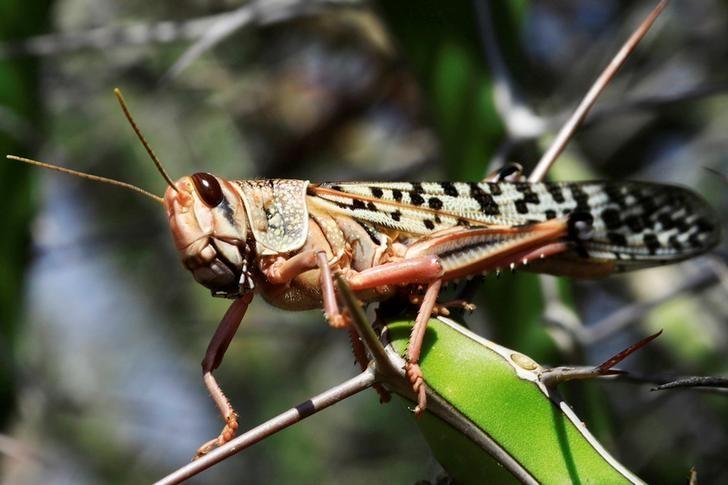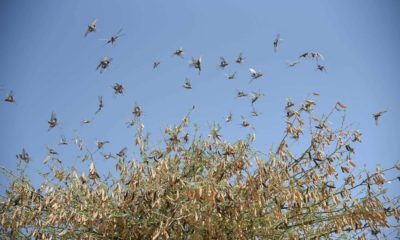News
Why We Can’t Eat Out The Locust Menace

There has been an intriguing talk about how the locust invasion menace, which is in eight counties now and supposedly getting out of hand, that the locusts can be turned into meals.
But can we really eat out the locust? Can they be trapped, fried and reserved? Who will do that and at what cost—the taxpayers will be facilitating this? Who wants to eat the locust? Do they really need them?
According to Dr Stephen Njoka, the Director of Desert Locust Control Organization for Eastern Africa, trapping and frying the insects can’t be a viable and much needed solution to efforts to eradicate the desert locusts.
“You cannot finish all the locusts by eating them, one swarm may have up to 40 million insects,” Njoka said.
“The communities that eat them should be careful not to eat the ones that have been sprayed with the pesticide,” Njoka warned the public.
Speaking at his first press conference since appointment as Cabinet Secretary Ministry of Agriculture, Peter Munya said the government is in control and the locust problem will soon end.
“We are adding more resources to contain the problem in key areas of Marsabit, Isiolo and Mandera,” he said adding that the government has hired three more aircraft to be deployed tomorrow (Thursday).
The locust started crossing the border of Ethiopia and Somalia into Kenya late last month. They have so far invaded eight counties of Mandera, Wajir, Marsabit, Garissa, Isiolo, Meru, Samburu and Laikipia.
The government has no actual figures of the amount of destruction coursed by the desert locusts in Kenya so far, but they have destroyed 175,000 acres of farmland in Somalia and Ethiopia according to the Food and Agriculture Organisation (FAO).
“The swarms of locusts are feeding in a non-discriminatory manner on the green matter. This will bring famine to both humans and animals. Controlling them will be a challenge unless the government increases capitation and tools to control the pests,” said Timothy Munywoki, senior agronomist at Amiran Kenya Limited in charge of crop protection and product development.
According to NASA’s Earth Observatory, part of an average swarm can eat the same amount of food in one day as about 10 elephants, 25 camels, or 2,500 people.
Kenya had a locust invasion in 2007 but the situation was contained. The last time the country had a locust invasion that was similarly threatening was in 1961.
The documents at the Desert Locust Control Organisation for Eastern Africa (DLCO-EA) that was formed in 1962 in response to a locust invasion in 1961 state that the current threat was similar to that of 1961. Kenya had a locust invasion in 2007 too but was contained. DLCO-EA reports indicate that the plague that wrecked Eastern Africa region causing massive hunger and deaths across happened in 1940s.
Kenya Insights allows guest blogging, if you want to be published on Kenya’s most authoritative and accurate blog, have an expose, news TIPS, story angles, human interest stories, drop us an email on [email protected] or via Telegram
-

 Investigations2 weeks ago
Investigations2 weeks agoHow Land Grabbing Cartels Have Captured Ardhi House
-

 Business2 weeks ago
Business2 weeks agoPanic As Payless Africa Freezes With Billions of Customers Cash After Costly Jambopay Blunder
-

 News3 days ago
News3 days agoTemporary Reprieve As Mohamed Jaffer Wins Mombasa Land Compensation Despite Losing LPG Monopoly and Bitter Fallout With Johos
-

 News2 weeks ago
News2 weeks agoSCANDAL: Cocoa Luxury Resort Manager Returns to Post After Alleged Sh28 Million Bribe Clears Sexual Harassment and Racism Claims
-

 Investigations1 week ago
Investigations1 week agoHow SportPesa Outfoxed Paul Ndung’u Of His Stakes With A Wrong Address Letter
-

 Investigations3 days ago
Investigations3 days agoFrom Daily Bribes to Billions Frozen: The Jambopay Empire Crumbles as CEO Danson Muchemi’s Scandal-Plagued Past Catches Up
-

 Sports2 days ago
Sports2 days ago1Win Games 2025: Ultimate Overview of Popular Casino, Sports & Live Games
-

 Business3 days ago
Business3 days agoHass Petroleum Empire Faces Collapse as Court Greenlights KSh 1.2 Billion Property Auction




























